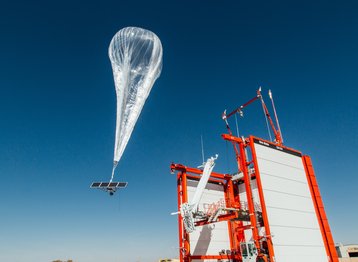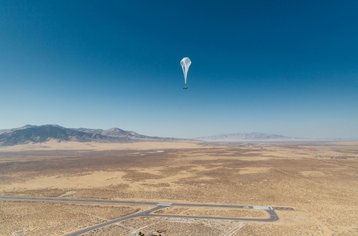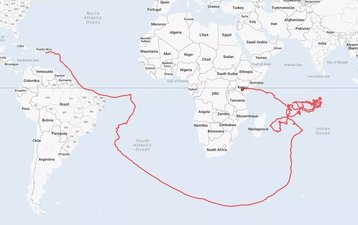Update 22 January: Alphabet has announced the closure of the Loon project. Read more here
A high-altitude balloon sounds like an eccentric way to deliver the Internet but Loon, an Alphabet company, has spent the last decade figuring out how to deliver it.
Loon is taking unconventional means to solve an otherwise impossible problem: bringing the Internet to rural regions that otherwise could not afford it. As Loon’s CTO, Sal Candido told DCD in an interview: “We provide connectivity, the idea is to do it all the time in all places. There are over a billion people in the world who don't have connectivity right now.”
Loon started in 2011 at Google's research division Google X, with a plan to beaming the Internet down to rural and isolated areas from high-altitude balloons that float in the Earth’s stratosphere between 11 to 16 miles up.
This feature appeared in the November issue of the DCD Magazine. Subscribe for free today.
Floating Internet
After a few years of research, Loon was spun off as a separate subsidiary of Google's parent in 2018. Since then it has tested its technology in various countries including the US, New Zealand, Sri Lanka, and Brazil.
Candido has been on the project since it started in 2011 and has seen it transform from a blue-sky prototype to a solid proposition in the blue skies - as a for-profit organization which inserts itself into countries as a stop-gap that links up isolated areas which local telcos can’t afford to cover on their own.
The company uses helium balloons, 15m across, made of polythene that is less than one-hundredth of a millimeter thick. Each craft is equipped with 10kg (22lb) of electronics, including a radio hot-spot, LTE networking equipment, and powered by solar panels. Each balloon lasts about six months before the entire thing is landed and picked up by collection teams.
A remarkable amount of flexibility comes with these balloons and the cost of each craft comes in at around $40,000. “What balloons allow us to do is to cover medium-density areas,” Candido added, “a little bit more efficiently than you would be able to do with towers on the ground.”
The CTO made it very clear that Loon isn’t a one size fits all measure. It has limited bandwidth for multiple users. It is designed to support dozens of people in a square mile of the countryside, not the hundreds or thousands that you would see in London or New York.
The “pull” Candido says is that Loon can be inserted in areas where it usually is, “not economical to put down towers because there are not enough people to use those towers.” Essentially, Loon takes the equipment that would normally sit at the top of a cell tower, adapts it for long-distance operations, and sets it floating in the stratosphere.
“We look at ourselves as a long-term piece of infrastructure… we’re able to add resiliency if a terrestrial network goes down,” he adds.
In 2017, Hurricane Maria hit the Caribbean and the advantages of floating cell towers became blindingly obvious. With the help of AT&T and T-Mobile, the company was able to get its aerostats in place and start beaming down the Internet to civilians in Puerto Rico soon after the disaster.
More than 3,000 people were killed by the hurricane and, in many places, terrestrial infrastructure such as cabling and cell towers were wrecked. Survivors in remote areas suffered due to a lack of communication, hampering relief efforts, and any hope of a return to normal.
In response, Loon got into gear and placed balloons over the affected areas, with its “floating cell towers” allowing previously disconnected people were able to communicate from inside refuge centers - and even to stream Netflix.
AI behind the controls
What’s most impressive is the way the balloons placed themselves in response to the crisis. At an instruction from Loon, they “chose” their own routes and positioned themselves to provide the connection the survivors needed.
The balloons are autonomous, given the nearly impossible task of controlling numerous systems floating in the stratosphere. Each system uses data about air currents to navigate themselves according to instructions. Each vehicle uses AI to intelligently adjust its altitude, so the balloon rides on different currents to “sail” to different regions in the world, and maintain its location once it is there.
This AI has led to some shocks. Shortly after the hurricane, Candido checked in on his fleet of balloons one early morning and almost spat out his coffee. He saw that four of his balloons were not following orders. As air currents caused them to drift away from their location, he’d given them a pre-programmed circuit that would bring them back to Puerto Rico - but they were ignoring that.
“Normally,” Candido said, “balloons that had finished a round of service above the island would float southwest, cross South America and eventually loop back to Puerto Rico to resume serving that needing connectivity.”
Instead, the balloons were hovering in a kind of “holding pattern.” Candido thought this was an error and attempted to investigate only to find the balloons knew better than their masters.
“Diving deep into the forecasts,” he said, “made it clear I had missed something. The winds, as it turned out, were expected to change in the coming days. The new winds would allow the balloons to simply drift straight back toward Puerto Rico, rather than taking the longer, circular route (which they were programmed to do) through South America.”
The balloons had used the data and spotted it would be more efficient to wait.
More recently, the company worked with Telefónica to help people out after a category eight earthquake in Peru knocked out connections in remote parts of the country.
Loon’s experience in Peru was different from the Puerto Rico disaster - right from the time it took for the balloons to arrive. It took four weeks to begin providing service in Puerto Rico, but the network was up in two days In Peru, partly because the balloons were already operating nearby, but also because navigational techniques had improved.
As a company, Loon is based out of a Google campus in Winnemucca, Nevada, where a lot of Alphabet’s engineering R&D departments test out some of its other innovative ideas. But as it has grown, it’s turned out that Nevada is not the best site for balloon launches.
To get service to new sites, Loon has the balloons deliver themselves. Some have gone up from Nevada and sailed off on high-atmosphere currents, but the team has switched its primary launch site to the country where it provided a much-needed emergency service.
“We didn't want to launch balloons off of Google's main campus and Puerto Rico is just a really good site for us to get balloons into the Tropics,” explained Candido.
With balloons that can travel long distances, the company doesn’t have to ship them, he told us: “What is closer to Kenya? Is it Italy or is it Puerto Rico? We did a whole bunch of calculations like that to figure out what are good launch sites for Loon based on the places that we want to be working on in the near term. The point is the balloons follow the wind.”
Prevailing winds make this a little more complex, as balloons often have to travel an apparently circuitous route. “When we want to provide service in Chile,” Candido added, “you may think you would want to launch in Argentina, it's right next to it, but it's on the wrong side because the wind is always going East.” Sometimes a balloon that wants to travel east to west has to follow a wind in the opposite direction until it can be looped around by the current.
Where the wind blows
The wind travels in different directions and at varying speeds depending on the altitude. When a balloon is launched the vehicle will float up and can adjust its height by changing the amount of helium in the envelope - choosing an altitude where the wind is favorable.
Puerto Rico is ideal because of its tropical latitude, making it possible for a Loon balloon to easily navigate to Africa - a continent where Loon suspects it will find many customers for its services.
Loon uses meteorological data from the National Oceanic and Atmospheric Administration (NOAA), to allow its craft to make navigation decisions. Each craft receives data from ground stations that are in turn connected to distant Google data centers. Inside each of these, locational updates to Loon’s navigational systems are conducted.
“Most of the wind data and the navigation smarts occur in our data centers,” Candido said. “And we just send the balloons a simple command, like ‘here's your plan for the next five minutes, and here is the plan for the next five hours’. It's in the data center that all the wind data is being processed; there's just not enough computation on the balloon itself.”
Before the company operates in any country Loon has to install ground infrastructure and connect to a local network, as well as secure flight permissions from authorities.
Loon beams Internet derived from local mobile operators or partners such as a regional telco which is wirelessly connected to deployable Edge locations operated by Loon. These ground stations send singles to the balloons, which can be routed between balloons before finally reaching the customer on the ground.
In July this year, the company finally launched its first commercial offering. After several tests and successful trials, the company now interconnects 35,000 people over 50,000 square kilometers (31,000 square miles) in Kenya’s Radad region. The 35 balloons being used offer average speeds of 18.9Mbps downlink, and 4.74Mbps uplink, with a 19-millisecond latency. Following this, Loon is looking to be deployed in Mozambique and Peru.
As of 2020, the fleet of balloons have flown for more than a million hours and traveled nearly 40 million kilometers (24 million miles) - enough to make 100 trips to the moon.



